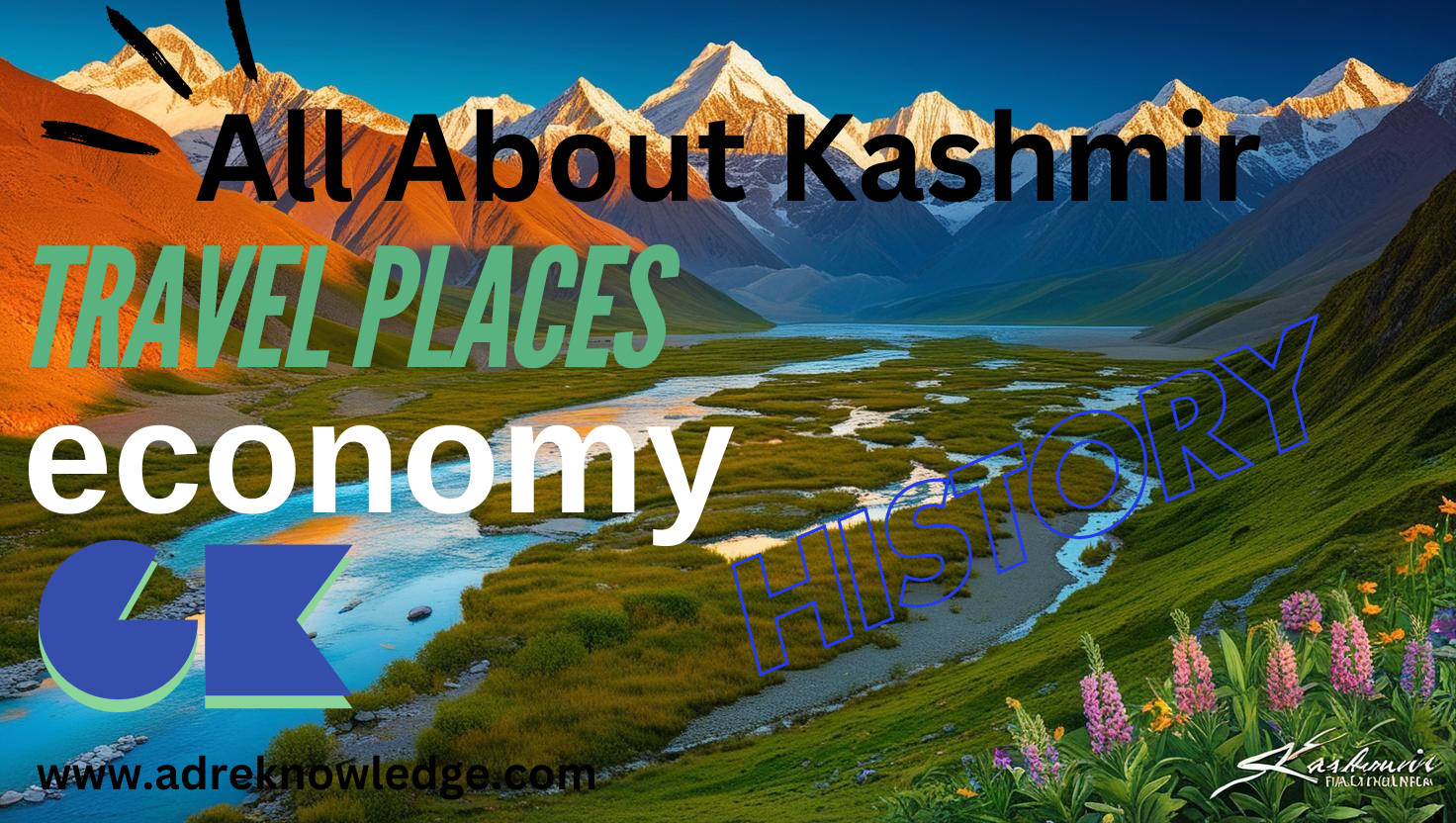All About Kashmir,Here are some importent General Knowledge(GK) Question About Kashmir. There is a Brife Introduction About Kashmir, Like Kashmir’s History, Kashmir’s Culture, Kashmir’s Tradition, Kashmir’s Economy Etc
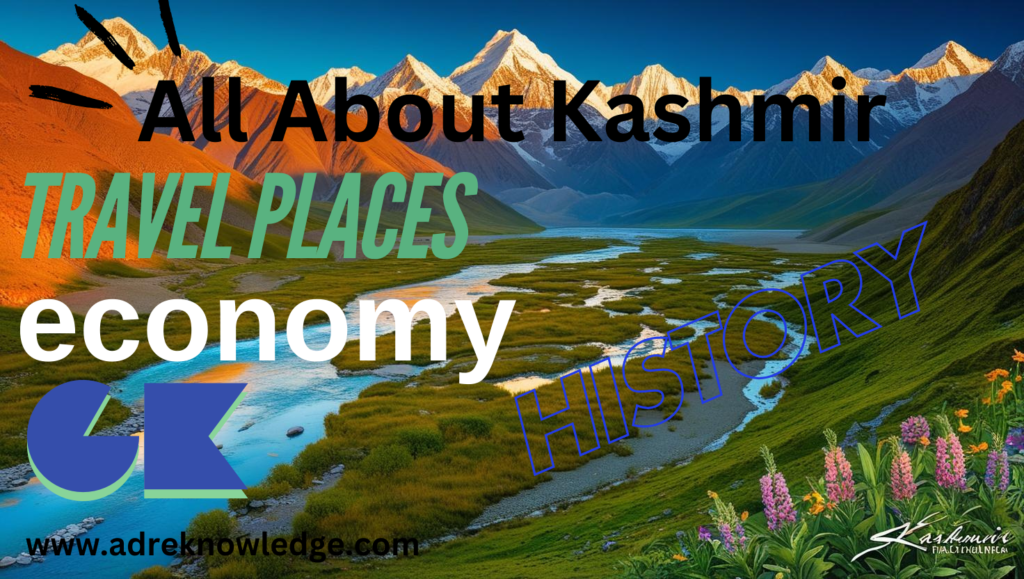
All About Kashmir
Kashmir, located in the northern part of the Indian subcontinent, is a region known for its beautiful landscapes, complex history, and strategic importance. The term “Kashmir” traditionally referred to the broader area, including the Indian-administered regions of Jammu, Kashmir Valley, and Ladakh, as well as the Pakistan-administered regions of Azad Jammu and Kashmir (AJK) and Gilgit-Baltistan. The area is often divided along the Line of Control (LoC), a de facto border between India and Pakistan established in 1949.
See Also:-https://adreknowledge.com/all-about-assam/
#Geography and Landscape
Kashmir Valley: Known for its breathtaking landscapes, including the Himalayan and Pir Panjal mountain ranges, pristine lakes (like Dal Lake and Wular Lake), and vast forests.
Jammu: Known as the “City of Temples,” Jammu is predominantly Hindu and home to Vaishno Devi Temple, a major pilgrimage site.
Ladakh: Situated in the high Himalayas, Ladakh is known for its unique culture, Buddhist monasteries, and rugged, high-altitude deserts.
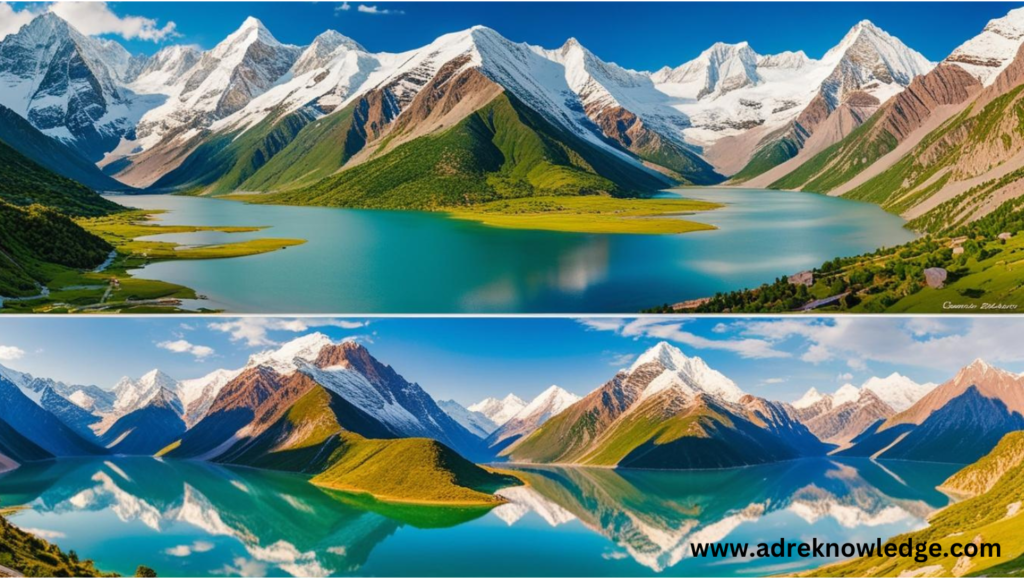
More About Kashmir’s Geography and Landscape:
Kashmir’s Geography and Landscape: Kashmir’s Geography and Landscape are marked by stunning natural beauty, with towering mountain ranges, lush valleys, expansive lakes, and verdant forests. The region lies at the northern tip of the Indian subcontinent, nestled between the Great Himalayas and the Pir Panjal mountain range, and has a diverse terrain that includes high-altitude deserts, dense forests, fertile plains, and glacial peaks.
1. Mountain Ranges
The Great Himalayas: To the northeast, this range features towering peaks, including Nun Kun and Stok Kangri, which reach altitudes of over 7,000 meters. The Himalayas provide a formidable natural boundary and contribute to the region’s dramatic climate and biodiversity.
Pir Panjal Range: This range borders the southwest of the Kashmir Valley and is slightly lower than the Himalayas. It’s known for high-altitude forests, alpine meadows, and valleys. Pir Panjal creates a natural barrier, protecting Kashmir Valley from the southwest monsoon rains.
2. Valleys
Kashmir Valley: One of the most fertile and densely populated areas, this valley lies between the Great Himalayas and Pir Panjal range. The Jhelum River flows through the valley, providing water for agriculture and daily life. Known for its lush landscapes, terraced fields, and gardens, it has earned the title “Paradise on Earth.”
Chenab Valley: Located in the Jammu region, the Chenab Valley is named after the Chenab River and is known for its hilly terrain and dense pine forests.
Ladakh Plateau: Ladakh is distinct, with high-altitude deserts and mountains. It is sparsely vegetated but offers striking landscapes with its rugged, barren mountains, crystal-clear rivers, and colorful prayer flags.
3. Lakes and Rivers
Dal Lake: Located in Srinagar, Dal Lake is famous for its houseboats, floating gardens, and shikara rides. It is one of Kashmir’s iconic sights and a major tourist attraction.
Wular Lake: One of the largest freshwater lakes in Asia, Wular Lake is located in the Bandipora district. The lake supports a diverse ecosystem, including migratory birds, and provides water for irrigation and fishing
.Jhelum River: Flowing through the Kashmir Valley, the Jhelum is central to agriculture, transportation, and daily life. It flows into Pakistan and eventually joins the Indus River.
Sindh and Lidder Rivers: These rivers are significant tributaries of the Jhelum, with the Lidder flowing through Pahalgam and contributing to the region’s unique ecosystems.
4. Forests
Temperate Forests: The lower elevations of Kashmir are covered in temperate forests, including pine, fir, and cedar. These forests are vital for the local economy, providing timber, medicinal herbs, and wildlife habitats.
Alpine Forests and Meadows: At higher altitudes, alpine meadows, called margs (like Gulmarg and Sonamarg), are surrounded by forests. These meadows bloom with wildflowers in the summer, providing grazing land and enhancing the region’s scenic beauty.
5. Glaciers
Kashmir is home to many glaciers, especially in Ladakh and parts of the Great Himalayas. The Siachen Glacier (the longest glacier in the Karakoram range) and Baltoro Glacier are among the most significant. These glaciers feed the rivers, making them crucial for the water supply across Kashmir and downstream in India and Pakistan.
6. Climate Zones
Subtropical Zone: Jammu lies in a subtropical climate zone, with hot summers and mild winters.
Temperate Zone: Kashmir Valley has a temperate climate, with mild summers and cold winters. Snowfall is common in winter, turning the valley into a picturesque white landscape.
Arid Zone: Ladakh has an arid, high-altitude desert climate, with extreme temperature variations between day and night. Summers are short, while winters are long and bitterly cold.
7. Biodiversity
Kashmir hosts diverse flora and fauna due to its varied geography. The region has deciduous forests, alpine meadows, and wetlands that provide habitats for animals like the Kashmir stag (hangul), Himalayan black bear, snow leopard, and various migratory birds.
8. Tourist Destinations Related to Geography
Gulmarg: Known for its meadows, skiing, and high-altitude golf course.
Sonamarg: Famous for its alpine meadows and the Thajiwas Glacier, which is accessible for trekking.
Pahalgam: A base for the Amarnath Yatra pilgrimage and known for its pine forests and the Lidder River.
Leh and Nubra Valley in Ladakh: Known for their monasteries, rugged terrain, and sand dunes at high altitudes.
Some Importent Question About Kashmir’s Geography and Economy:
1. Which river flows through the Kashmir Valley?
- A) Jhelum
- B) Ganges
- C) Yamuna
- D) Brahmaputra
- A) Jhelum (Correct)
2. Which lake is known for its floating gardens and houseboats in Srinagar?
- A) Dal Lake
- B) Wular Lake
- C) Pangong Lake
- D) Chilika Lake
- A) Dal Lake (Correct)
3. Which region of Kashmir is known as the “Land of High Passes”?
- A) Ladakh
- B) Jammu
- C) Pir Panjal
- D) Gilgit
- A) Ladakh (Correct)
4. What is the traditional multi-course meal of Kashmiri cuisine?
- A) Wazwan
- B) Thali
- C) Dosa
- D) Biryani
- A) Wazwan (Correct)
5. Which mountain range surrounds the Kashmir Valley to the southwest?
- A) Pir Panjal
- B) Aravalli
- C) Western Ghats
- D) Vindhya
- A) Pir Panjal (Correct)
6. What is the largest freshwater lake in Kashmir?
- A) Wular Lake
- B) Dal Lake
- C) Manasarovar Lake
- D) Sukhna Lake
- A) Wular Lake (Correct)
7. The traditional Kashmiri garment for winter, often used with an inner pot for warmth, is called:
- A) Pheran
- B) Ghagra
- C) Sherwani
- D) Saree
- A) Pheran (Correct)
8. The Mughal Emperor who called Kashmir “Paradise on Earth” was:
- A) Jahangir
- B) Akbar
- C) Aurangzeb
- D) Shah Jahan
- A) Jahangir (Correct)
9. Which popular tourist destination in Kashmir is famous for skiing?
- A) Gulmarg
- B) Sonamarg
- C) Pahalgam
- D) Leh
- A) Gulmarg (Correct)
10. The capital of the Jammu and Kashmir union territory in winter is:
- A) Jammu
- B) Srinagar
- C) Leh
- D) Anantnag
- A) Jammu (Correct)
All About Kashmir
#Demographics
Kashmir Valley: Predominantly Muslim population with a mix of ethnicities, including Kashmiri-speaking people.
Jammu: Mostly Hindu, with a mix of Dogras, Paharis, and other ethnic groups.
Ladakh: Largely Buddhist and Shia Muslim, with a mix of ethnic Ladakhis, including Tibetans.
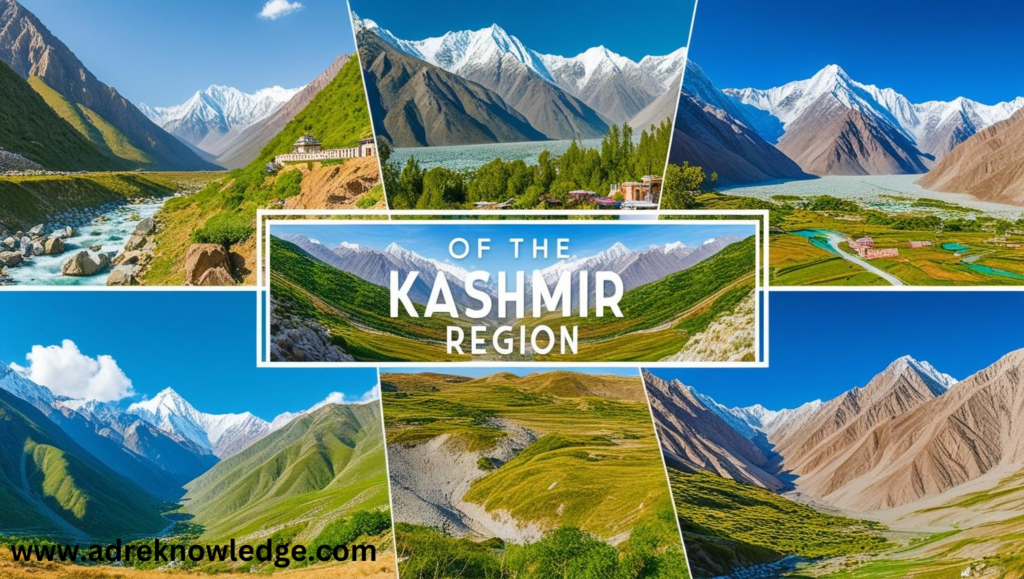
More About Kashmir’s Demogrsphics:
Kashmir has a diverse demographic profile shaped by a mix of ethnicities, religions, and cultures, reflecting its position at the crossroads of South Asia and Central Asia. The demographics of Kashmir can vary significantly across its different regions: the Kashmir Valley, Jammu, and Ladakh.
1. Population Overview
Total Population: Jammu and Kashmir had an estimated population of around 13 million in the 2011 census, while Ladakh has a much smaller population, around 300,000.
Density: The Kashmir Valley has a high population density, while Ladakh, with its harsh, high-altitude terrain, has one of the lowest population densities in India.
Urban vs. Rural: Most of the population in the Kashmir Valley is rural, with only a few major cities, like Srinagar. Jammu has more urban centers, and Ladakh is primarily rural with small towns like Leh and Kargil.
2. Ethnic Groups
Kashmiris: The majority ethnic group in the Kashmir Valley, speaking Kashmiri (Koshur) as their primary language. Most Kashmiris are of Indo-Aryan descent.
Dogras: Predominantly found in the Jammu region, Dogras are known for their distinct culture and language, Dogri. They are primarily Hindu.
Ladakhis: The people of Ladakh are ethnically Tibetan, with a distinct cultural heritage and language (Ladakhi or Bhoti). They follow Tibetan Buddhism and Shia Islam.
Gujjars and Bakarwals: Nomadic communities primarily in Jammu and Kashmir Valley. Gujjars and Bakarwals traditionally practice pastoralism, moving between pastures with their herds.
Paharis: Found in both Jammu and Kashmir regions, Paharis have their own language and distinct culture.
3. Religious Composition
Muslims: Predominant in the Kashmir Valley, constituting around 97% of the population there. A significant portion of Muslims in Kashmir follow Sufism, and there is a mix of Sunni and Shia communities. Ladakh has a sizable Shia Muslim population, especially in Kargil.
Hindus: Concentrated in Jammu, where they form the majority. They include Dogras and smaller communities like Kashmiri Pandits, who were originally based in the Kashmir Valley.
Buddhists: Predominantly found in Ladakh, especially in the Leh district, following Tibetan Buddhism. The Buddhists in Ladakh have a unique cultural identity and are closely tied to Tibetan heritage.
Sikhs: There is a small but significant Sikh community, primarily in the Jammu region and parts of the Kashmir Valley.
4. Languages
Kashmiri (Koshur): Primarily spoken in the Kashmir Valley, it’s one of the region’s official languages. It’s an Indo-Aryan language with Persian, Arabic, and Sanskrit influences.
Dogri: Predominantly spoken in the Jammu region, Dogri is another Indo-Aryan language. It has its own script, though it’s often written in Devanagari or Urdu.
Urdu: The official language of Jammu and Kashmir, widely spoken across the region, especially as a second language.
Ladakhi: A Tibetic language spoken in Ladakh. In Leh, people speak the Ladakhi dialect, while Balti, a related language, is spoken in Kargil.
Gojri: Spoken by the Gujjar and Bakarwal communities, it’s an important language for these pastoralist groups.
5. Migration and Displacement
Kashmiri Pandit Migration: During the insurgency in the late 1980s and early 1990s, many Kashmiri Pandits, a Hindu minority, migrated from the Kashmir Valley to other parts of India, particularly Jammu.
Gujjars and Bakarwals: As nomadic tribes, Gujjars and Bakarwals traditionally migrate between Jammu and Kashmir’s mountainous regions with their livestock.
6. Education and Literacy
Literacy Rate: Jammu and Kashmir’s literacy rate is slightly below the national average, with Jammu having a higher literacy rate than the Kashmir Valley. Ladakh has seen recent improvements in education access but still has relatively low literacy due to its remote geography.
Educational Challenges: Access to education, especially in rural and remote areas like Ladakh, is a challenge. Periods of unrest in the Kashmir Valley have disrupted educational access there.
7. Social Structure and Occupation
Agriculture: The majority in Kashmir Valley are engaged in agriculture, with rice, apples, and saffron being major crops. In Ladakh, barley and vegetables are the primary agricultural products.
Tourism: Tourism is a major source of employment, especially in Kashmir Valley and Ladakh.
Handicrafts: Many people are involved in the production of traditional handicrafts, like Pashmina shawls, carpets, and woodwork, particularly in the Kashmir Valley.
8. Population Distribution and Settlements
Srinagar: The largest city and summer capital of Jammu and Kashmir, it is a cultural and economic center.
Jammu: The winter capital, with a mix of Hindu and Muslim populations, serves as a cultural and religious center for Dogras.
Leh and Kargil: Key towns in Ladakh, with Leh being the cultural heart for Buddhists and Kargil predominantly Muslim.
9. Youth Population and Employment
The region has a large youth population, with over half under 25. However, unemployment rates are higher than the national average, especially in Kashmir Valley, due to limited industrialization and periods of unrest affecting economic opportunities.
Some Importent Question About Kashmir’s Demograsphics:
1. What is the primary religion in the Kashmir Valley?
- A) Islam
- B) Hinduism
- C) Buddhism
- D) Sikhism
- A) Islam (Correct)
2. Which ethnic group is primarily found in the Jammu region?
- A) Dogras
- B) Ladakhis
- C) Gujjars
- D) Tibetans
- A) Dogras (Correct)
3. What is the primary language spoken in the Kashmir Valley?
- A) Kashmiri (Koshur)
- B) Dogri
- C) Urdu
- D) Punjabi
- A) Kashmiri (Koshur) (Correct)
4. Which community is known for their nomadic lifestyle in Jammu and Kashmir?
- A) Gujjars and Bakarwals
- B) Dogras
- C) Ladakhis
- D) Paharis
- A) Gujjars and Bakarwals (Correct)
5. What is the official language of Jammu and Kashmir?
- A) Urdu
- B) Hindi
- C) Kashmiri
- D) English
- A) Urdu (Correct)
6. Which region in Jammu and Kashmir has the highest concentration of Buddhists?
- A) Ladakh
- B) Jammu
- C) Kashmir Valley
- D) Pir Panjal
- A) Ladakh (Correct)
7. The traditional language spoken by the Dogra people in Jammu is:
- A) Dogri
- B) Kashmiri
- C) Balti
- D) Gojri
- A) Dogri (Correct)
8. The primary occupation of people in the Kashmir Valley is:
- A) Agriculture
- B) Mining
- C) Fishing
- D) Manufacturing
- A) Agriculture (Correct)
9. The region in Jammu and Kashmir with the lowest population density is:
- A) Ladakh
- B) Jammu
- C) Kashmir Valley
- D) Pir Panjal
- A) Ladakh (Correct)
10. Which of the following is a significant Hindu pilgrimage site in Jammu and Kashmir?
- A) Vaishno Devi
- B) Hemis Monastery
- C) Jamia Masjid
- D) Lamayuru Monastery
- A) Vaishno Devi (Correct)
All About Kashmir
#Political and Administrative Division
In 1947, the region became a contentious area between India and Pakistan after the Partition. Both countries claim Kashmir but control different parts.
In August 2019, the Indian government abrogated Article 370 of its Constitution, which granted special autonomy to Jammu and Kashmir, reorganizing it into two separate union territories: Jammu & Kashmir and Ladakh.
Pakistan administers parts of the region as Azad Jammu and Kashmir (AJK) and Gilgit-Baltistan.

More About Kashmir’s Political and Administrative Division:
The political and administrative divisions of Kashmir are complex and rooted in the region’s tumultuous history. Kashmir is divided into territories administered by India, Pakistan, and, to a smaller extent, China. This division has created a unique political structure and administration system, with each region having distinct governance.
1. Historical Background
At the time of India’s independence in 1947, the princely state of Jammu and Kashmir was given the choice to join either India or Pakistan. The then-Maharaja Hari Singh chose to accede to India under certain conditions, leading to the inclusion of Article 370 in the Indian Constitution, granting Jammu and Kashmir special autonomy.
This decision resulted in conflict, leading to the first Indo-Pakistani war (1947-48). The region was divided along the Line of Control (LoC) after a United Nations-brokered ceasefire in 1949.
2. Division of Kashmir
Indian-administered Jammu and Kashmir: Consists of the Jammu region, the Kashmir Valley, and Ladakh (now a separate Union Territory).
Pakistan-administered Kashmir: Comprises two regions—Azad Jammu and Kashmir (AJK) and Gilgit-Baltistan.
Chinese-administered Aksai Chin: In the eastern part, Aksai Chin is administered by China and claimed by India.
3. Article 370 and Article 35A
Article 370: Granted Jammu and Kashmir autonomy, allowing it to have its own constitution and laws in all areas except defense, communications, and foreign affairs.
Article 35A: This provision allowed the state to define “permanent residents” and provide them special rights and privileges.
Revocation in August 2019: The Indian government abrogated Article 370, effectively revoking Jammu and Kashmir’s special status. The state was reorganized into two union territories, Jammu & Kashmir and Ladakh, bringing it directly under central administration.
4. Current Administrative Division (Post-2019)
Union Territory of Jammu and Kashmir:
Consists of the Jammu and Kashmir Valley regions.
Has a Legislative Assembly with limited powers similar to other union territories with legislatures (e.g., Delhi).
The head of the administration is a Lieutenant Governor appointed by the President of India.
Capital: Srinagar (summer capital) and Jammu (winter capital).
Has a Legislative Assembly that governs domestic matters, while issues like law and order and police are managed by the central government.
Union Territory of Ladakh:
Comprises Leh and Kargil districts.
Directly administered by the central government, with no legislature of its own.
Headed by a Lieutenant Governor.
Capital: Leh.
Local matters are managed by the Ladakh Autonomous Hill Development Councils in Leh and Kargil, which handle areas such as health, education, and local development.
5. Pakistan-administered Kashmir
Azad Jammu and Kashmir (AJK):
Has its own President, Prime Minister, and Legislative Assembly, which exercises some autonomy but remains under Pakistan’s oversight for defense, currency, and foreign policy.
AJK has a parliamentary form of government, and Urdu is the official language.
Gilgit-Baltistan:
Operates as a separate administrative unit from AJK.
Governed by the Gilgit-Baltistan Legislative Assembly and a Chief Minister, with oversight from Pakistan’s federal government.
The region lacks formal provincial status, though it has received increased administrative autonomy in recent years.
6. China-administered Aksai Chin
Aksai Chin is under Chinese control and is part of the Tibet Autonomous Region and Xinjiang.
It is sparsely populated and mostly consists of high-altitude desert.
7. Security and Military Presence
The Line of Control (LoC) separates the Indian and Pakistan-administered regions and is heavily militarized.
India and Pakistan maintain significant troop deployments along the LoC, and the region has been a flashpoint for armed conflicts and skirmishes.
The Siachen Glacier in Ladakh is also militarized and is one of the highest battlegrounds in the world.
8. Local Governance and Representation
Panchayati Raj Institutions (PRIs) in Jammu and Kashmir: These institutions play a role in local self-governance, especially after recent reforms post-2019, aiming to enhance local administration and development.
Hill Development Councils in Ladakh: The Leh and Kargil Autonomous Hill Development Councils manage local governance in Ladakh. These councils focus on issues like local infrastructure, healthcare, and education.
9. Political Parties and Elections
In the union territory of Jammu and Kashmir, major political parties include the Jammu and Kashmir National Conference (NC), People’s Democratic Party (PDP), Bharatiya Janata Party (BJP), and Indian National Congress (INC).
Elections in Jammu and Kashmir are held under the same constitutional framework as other Indian states and union territories. Ladakh, however, does not have its own legislature and is administered directly by the central government.
10. Cross-Border Ties and Diplomatic Concerns
Cross-border ties and diplomatic efforts have at times led to talks between India and Pakistan, with varying success.
Confidence-building measures have included establishing bus routes and trade across the LoC, such as the Srinagar-Muzaffarabad and Poonch-Rawalakot routes.
11. Legal and Judicial Systems
Indian-administered Jammu and Kashmir: The region is subject to the Indian legal system, with the High Court of Jammu and Kashmir handling local cases.
Pakistan-administered AJK: It has its own judiciary, with a Supreme Court and High Court, though they operate under the broader judicial framework of Pakistan.
Some importent Question About Kashmir’s Political and Administrative Division:
1. After the revocation of Article 370 in August 2019, how was Jammu and Kashmir reorganized?
- A) Into two Union Territories: Jammu & Kashmir and Ladakh
- B) Into a single Union Territory of Jammu and Kashmir
- C) Into two new states: Jammu and Kashmir
- D) No changes were made
- A) Into two Union Territories: Jammu & Kashmir and Ladakh (Correct)
2. Which area of Kashmir is controlled by China?
- A) Aksai Chin
- B) Gilgit-Baltistan
- C) Azad Jammu and Kashmir
- D) Siachen Glacier
- A) Aksai Chin (Correct)
3. What is the summer capital of the Union Territory of Jammu and Kashmir?
- A) Srinagar
- B) Jammu
- C) Leh
- D) Kargil
- A) Srinagar (Correct)
4. What is the main governing body of Ladakh in terms of local development and administration?
- A) Ladakh Autonomous Hill Development Councils
- B) Leh District Council
- C) Jammu & Kashmir Legislative Assembly
- D) Ladakh Legislative Assembly
- A) Ladakh Autonomous Hill Development Councils (Correct)
5. Which line divides Indian-administered and Pakistan-administered Kashmir?
- A) Line of Control (LoC)
- B) Line of Actual Control (LAC)
- C) McMahon Line
- D) Durand Line
- A) Line of Control (LoC) (Correct)
6. Which city serves as the winter capital of Jammu and Kashmir?
- A) Jammu
- B) Srinagar
- C) Leh
- D) Poonch
- A) Jammu (Correct)
7. Which of the following regions has its own President and Prime Minister under Pakistan’s administration?
- A) Azad Jammu and Kashmir
- B) Gilgit-Baltistan
- C) Aksai Chin
- D) Jammu and Kashmir
- A) Azad Jammu and Kashmir (Correct)
8. Which region under Pakistan’s administration is NOT formally considered a province but has its own Legislative Assembly?
- A) Gilgit-Baltistan
- B) Azad Jammu and Kashmir
- C) Aksai Chin
- D) Kashmir Valley
- A) Gilgit-Baltistan (Correct)
9. What special powers did Article 370 provide to the state of Jammu and Kashmir before its revocation?
- A) Autonomy with its own constitution and laws
- B) Right to secede from India
- C) Complete control over its foreign relations
- D) Exemption from Indian law enforcement agencies
- A) Autonomy with its own constitution and laws (Correct)
10. Who is the head of administration in the Union Territories of Jammu & Kashmir and Ladakh?
- A) Lieutenant Governor
- B) Chief Minister
- C) Prime Minister
- D) President
- A) Lieutenant Governor (Correct)
All About Kashmir
#Economy
Agriculture: Known for rice, maize, and wheat production, and especially for saffron in the Kashmir Valley.
Tourism: The scenic beauty of Kashmir draws tourists, particularly to Srinagar, Gulmarg, and Leh.
Handicrafts: Famous for Pashmina shawls, Kashmiri carpets, papier-mâché items, and wood carvings.
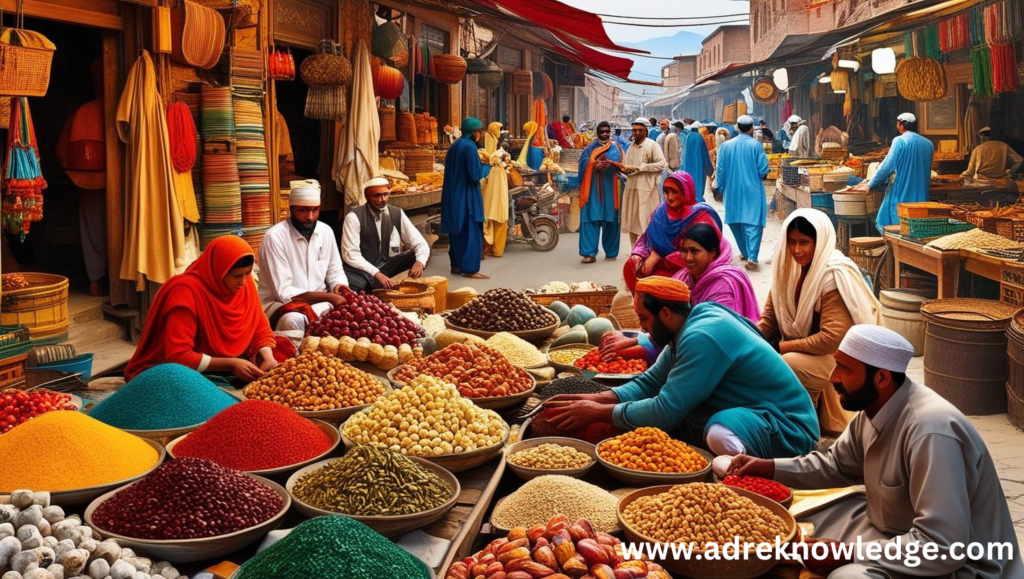
More About Kashmir’s Economy:
The economy of Kashmir is diverse, rooted in its natural resources, agriculture, and a rich cultural heritage. However, it is also influenced by the region’s political situation and geographical challenges. Here’s a breakdown of the key sectors and challenges in Kashmir’s economy:
1. Agriculture and Horticulture
Agriculture: Kashmir has a largely agrarian economy, with agriculture employing over 60% of the population. The fertile soil of the Kashmir Valley supports crops like rice, maize, wheat, and barley.
Horticulture: Kashmir is known for its high-quality fruits, particularly apples, apricots, walnuts, and cherries. The region is the largest producer of apples in India, with Kashmiri apples exported across the country and internationally.
Saffron Cultivation: Kashmir is one of the few regions in the world where saffron, a highly valued spice, is cultivated. The region’s Pampore area is famous for saffron production, making it a significant contributor to Kashmir’s economy.
2. Handicrafts and Cottage Industries
Carpets and Shawls: Kashmiri carpets, especially hand-knotted silk and wool carpets, are highly valued globally. Pashmina shawls, made from fine cashmere wool, are another luxury item exported from Kashmir.
Papier-mâché: This traditional art involves intricate designs and is popular in both local and international markets.
Woodwork: The region is known for walnut wood furniture and decorations, which are intricately carved and in high demand.
Metalwork and Copperware: Traditional copper utensils, such as samovars (tea kettles) and serving dishes, are unique to Kashmir and form part of its cultural heritage.
3. Tourism
Natural Attractions: Known for its breathtaking landscapes, Kashmir has a long history of tourism. Destinations like Gulmarg, Pahalgam, Sonamarg, and Dal Lake in Srinagar attract domestic and international tourists for sightseeing, trekking, and skiing.
Pilgrimage Tourism: The region sees an influx of pilgrims visiting the Amarnath Cave and Vaishno Devi Temple (in Jammu), which are two of India’s major pilgrimage sites.
Adventure Tourism: Adventure sports like skiing, river rafting, trekking, and mountaineering have gained popularity, especially in the Gulmarg area, which is known as a winter sports destination.
Challenges: The political instability has often deterred international tourists and impacted tourism revenue. Nonetheless, tourism remains a major contributor to Kashmir’s economy, providing direct and indirect employment.
4. Floriculture
Kashmir’s climate is conducive to floriculture, with the cultivation of various flowers like tulips, roses, and marigolds. The Tulip Garden in Srinagar, the largest in Asia, is a popular attraction and supports floriculture as an economic activity.
5. Sericulture (Silk Production)
Kashmir’s sericulture industry, especially in the Jammu region, produces raw silk that is in high demand. Silk weaving and spinning are traditional crafts in the region, though the industry has faced challenges from modernization and competition from synthetic fibers.
6. Power Generation
The hydropower sector has significant potential due to the region’s rivers and mountainous terrain. Major rivers like the Jhelum, Chenab, and Indus provide opportunities for large hydropower projects.
Several hydropower plants operate in the region, supplying power to the region and parts of northern India. Despite its potential, the full capacity of Kashmir’s hydropower resources remains untapped, with infrastructure development limited by geographical and political factors.
7. Forestry
Forests cover much of the Kashmir Valley and the surrounding regions, providing timber, medicinal plants, and herbs. Timber is an important resource, though strict regulation on deforestation aims to preserve forest resources.
Medicinal Herbs: The forests are home to a variety of herbs used in traditional medicine, which are harvested for local use and export. Kashmiri forests are known for herbs like lavender, rose, and wild mint.
8. Livestock and Dairy Farming
Livestock farming is a significant part of the economy, especially for nomadic communities like the Gujjars and Bakarwals. Sheep farming is widespread, producing wool for the textile industry and meat.
Dairy Farming: Dairy production is also important, providing milk, cheese, and other products, particularly in rural areas. However, productivity is lower than the national average due to limited infrastructure.
9. Trade and Cross-Border Trade
The Indian government has established cross-LoC (Line of Control) trade routes to promote economic cooperation between the Indian and Pakistan-administered regions of Kashmir. These routes, such as Srinagar-Muzaffarabad and Poonch-Rawalakot, are used for trade in limited goods.
However, political tensions have affected cross-border trade and restricted the movement of goods across these routes.
10. Challenges to Economic Growth
Political Instability: The prolonged conflict in the region has resulted in economic disruption, reducing foreign investment and affecting tourism.
Infrastructure: Kashmir’s infrastructure, particularly in rural and remote areas, is underdeveloped. Limited road access, power shortages, and communication restrictions have impeded industrial growth.
Unemployment: Unemployment remains a significant issue, especially among the youth. Despite a high literacy rate, limited job opportunities in the private and public sectors have led to high levels of youth unemployment.
Environmental Concerns: Deforestation, water pollution, and shrinking wetlands have impacted agriculture, horticulture, and tourism.
11. Government Initiatives and Economic Reforms
Skill Development: Programs to enhance local skills, particularly in tourism, handicrafts, and information technology, aim to reduce unemployment.
Financial Aid and Subsidies: The government has provided financial aid, subsidies, and low-interest loans to support agriculture, handicrafts, and small industries.
Industrial Development Schemes: Incentives for small-scale industries, such as tax exemptions and subsidies, encourage entrepreneurship in Jammu and Kashmir.
Some Importent Question About Kashmir’s Economy:
1. What is the primary agricultural product for which Kashmir is renowned?
- A) Apples
- B) Bananas
- C) Oranges
- D) Mangoes
- A) Apples (Correct)
2. Which traditional craft is Kashmir particularly famous for producing?
- A) Pashmina shawls
- B) Silk saris
- C) Leather goods
- D) Metal utensils
- A) Pashmina shawls (Correct)
3. What is the main source of hydropower generation in Kashmir?
- A) Rivers like the Jhelum and Chenab
- B) Wind turbines
- C) Solar panels
- D) Geothermal sources
- A) Rivers like the Jhelum and Chenab (Correct)
4. Which type of tourism significantly contributes to Kashmir’s economy?
- A) Adventure tourism
- B) Space tourism
- C) Eco-tourism
- D) Medical tourism
- A) Adventure tourism (Correct)
5. What is the key spice that is predominantly cultivated in Kashmir?
- A) Saffron
- B) Turmeric
- C) Black pepper
- D) Cinnamon
- A) Saffron (Correct)
6. Which handicraft is most associated with the Kashmir Valley?
- A) Hand-knotted carpets
- B) Wooden toys
- C) Glass beads
- D) Pottery
- A) Hand-knotted carpets (Correct)
7. What is the major challenge faced by the agricultural sector in Kashmir?
- A) Political instability
- B) Abundant water supply
- C) High demand for produce
- D) Excellent infrastructure
- A) Political instability (Correct)
8. Which sector has seen significant development potential in Kashmir but is still underutilized?
- A) Hydropower
- B) Nuclear energy
- C) Fossil fuels
- D) Coal mining
- A) Hydropower (Correct)
9. What form of livestock farming is particularly prevalent among the nomadic communities in Kashmir?
- A) Sheep farming
- B) Cattle farming
- C) Poultry farming
- D) Goat farming
- A) Sheep farming (Correct)
10. Which region is known for its lucrative production of walnut wood crafts in Kashmir?
- A) Jammu
- B) Ladakh
- C) Kashmir Valley
- D) Pir Panjal
- A) Jammu (Correct)
All About Kashmir
#Culture
Kashmir has a unique cultural identity influenced by Central Asian, Persian, and Indian cultures.
The region is known for its Sufi music, traditional dance forms, and unique culinary traditions like Wazwan (a multi-course Kashmiri meal).
Languages spoken include Kashmiri, Urdu, Ladakhi, Dogri, and Hindi.
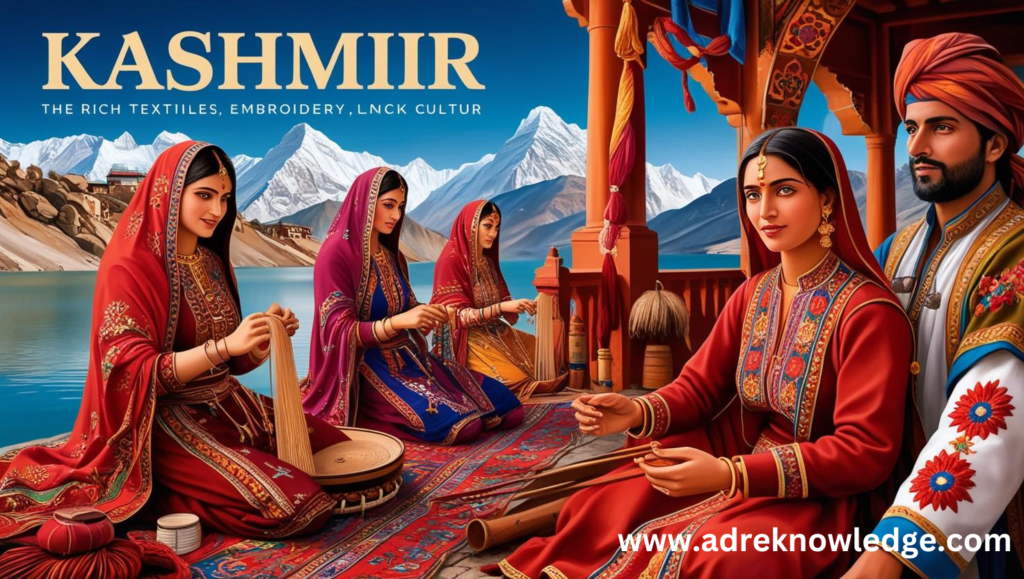
More About Kashmiri Culture:
Kashmiri culture is rich and diverse, shaped by the region’s unique history, geography, and the confluence of various influences over centuries. The culture reflects a blend of traditions from various ethnic groups, religions, and historical periods, creating a distinctive identity. Here are the key elements that characterize Kashmiri culture:
1. Language
Kashmiri (Koshur): The primary language spoken in the Kashmir Valley, it belongs to the Dardic group of languages and has its own script, Sharda. It is a significant part of Kashmiri identity.
Urdu: Widely used as a lingua franca and is also the official language in Jammu and Kashmir.
Dogri and Hindi: Spoken in the Jammu region and are part of the cultural mosaic.
2. Religion
Islam: The predominant religion in the Kashmir Valley, with a majority of the population being Sunni Muslims, followed by a significant Shia community.
Hinduism: Predominantly practiced in the Jammu region, with many ancient temples and pilgrimage sites.
Buddhism: Particularly in the Ladakh region, where Tibetan Buddhism is widely followed.
Sikhism: Also has a presence, especially in Jammu, with several gurdwaras.
3. Cuisine
Kashmiri Cuisine: Known for its aromatic flavors, it includes dishes such as Rogan Josh (lamb curry), Yakhni (yogurt-based curry), and Dum Olav (spiced potatoes).
Wazwan: A traditional multi-course meal served at weddings, featuring an array of dishes, notably meat dishes, presented in a grand manner.
Kashmiri Sweets: Include Gulab Jamun, Bakarkhani, and Kashmiri Halwa.
4. Festivals
Eid al-Fitr and Eid al-Adha: Major Islamic festivals celebrated with prayers, feasting, and community gatherings.
Shivratri (Herath): A significant Hindu festival celebrated with rituals and offerings.
Buddha Purnima: Celebrated in Ladakh by the Buddhist community.
Navratri: Celebrated by the Hindu community with fasting and prayers.
5. Art and Handicrafts
Pashmina Shawls: Handwoven shawls made from the fine wool of the Changthangi goat, known for their warmth and softness.
Kashmiri Carpets: Renowned for their intricate designs and craftsmanship, often featuring floral patterns.
Papier-mâché: A traditional craft involving the creation of decorative items and furniture using paper pulp.
Woodwork: Elaborately carved walnut wood products, including furniture and decorative pieces.
6. Music and Dance
Sufiana Music: Traditional Sufi music played on instruments like the santoor, rabab, and dhol. This music often features poetic themes of love and spirituality.
Dances: Traditional dances such as Rouf (performed by women during celebrations) and Wangoo (a folk dance performed in pairs) are an integral part of cultural festivities.
7. Clothing
Kashmiri Attire: Traditional attire includes the Pheran (a long woolen cloak) for men and women, often worn with a Kashmiri cap. Women may wear colorful shawls and embroidered kurtas.
Pashmina Stoles and Shawls: Widely worn, especially in winter.
8. Architecture
Traditional Houses: Known as Dukhtaran-e-Kashmir, they are built with wooden beams and intricate carvings. Houses often feature a courtyard.
Mosques and Temples: Notable examples include the Jamia Masjid in Srinagar and the Raghunath Temple in Jammu. The architecture reflects a blend of Persian and indigenous styles.
9. Literature and Folklore
Kashmiri Literature: Encompasses poetry, prose, and folklore, often exploring themes of nature, love, and spirituality. Notable poets include Habba Khatoon and Nund Rishi.
Folktales and Legends: Rich oral traditions with stories reflecting the culture, morality, and history of the people.
10. Social Structure
Community and Family: Kashmiri society is traditionally close-knit, with strong emphasis on family and community ties.
Women’s Role: Women play an essential role in maintaining cultural practices, household management, and artisan crafts.
11. Education and Scholarship
Historically, Kashmir has been a center of learning and scholarship, with institutions like the Shankaracharya Temple and Kashmir University playing significant roles in education.
12. Current Challenges
The ongoing political conflict has had a profound impact on the cultural landscape, affecting traditions, the economy, and daily life. However, efforts to preserve and promote Kashmiri culture continue despite these challenges.
Some Importent Question About Kashmiri Culture:
1. What is the traditional long woolen cloak worn by both men and women in Kashmir called?
- A) Pheran
- B) Kurta
- C) Sherwani
- D) Chadar
- A) Pheran (Correct)
2. Which famous type of shawl is Kashmir known for, made from fine cashmere wool?
- A) Pashmina
- B) Kani
- C) Khadi
- D) Bandhani
- A) Pashmina (Correct)
3. What is the traditional multi-course meal served during Kashmiri weddings called?
- A) Wazwan
- B) Thali
- C) Biryani
- D) Pulao
- A) Wazwan (Correct)
4. Which festival, celebrated by Hindus, is significant in Kashmir and involves worship of Lord Shiva?
- A) Shivratri (Herath)
- B) Diwali
- C) Holi
- D) Makar Sankranti
- A) Shivratri (Herath) (Correct)
5. What is the primary language spoken in the Kashmir Valley?
- A) Kashmiri (Koshur)
- B) Punjabi
- C) Urdu
- D) Hindi
- A) Kashmiri (Koshur) (Correct)
6. Which traditional music form, often associated with Sufi poetry, is popular in Kashmir?
- A) Sufiana Music
- B) Bhangra
- C) Qawwali
- D) Ghazal
- A) Sufiana Music (Correct)
7. What is the primary material used in the famous Kashmiri handicraft of papier-mâché?
- A) Paper pulp
- B) Wood
- C) Metal
- D) Clay
- A) Paper pulp (Correct)
8. Which flower is famously celebrated during the Tulip Festival in Kashmir?
- A) Tulip
- B) Rose
- C) Lily
- D) Orchid
- A) Tulip (Correct)
9. What is the traditional folk dance performed by women in Kashmir during festivals?
- A) Rouf
- B) Bhangra
- C) Garba
- D) Kathak
- A) Rouf (Correct)
10. Which of the following is a traditional form of wooden craftsmanship in Kashmir?
- A) Walnut wood carving
- B) Bamboo furniture
- C) Rattan weaving
- D) Plastic molding
- A) Walnut wood carving (Correct)
All About Kashmir
#Current Challenges
Political Unrest: The region has experienced long-standing tension and periodic violence.
Environmental Issues: Glacial melting and deforestation threaten the fragile environment.
Human Rights: There are concerns over human rights, with reports of restrictions, curfews, and communication blackouts.
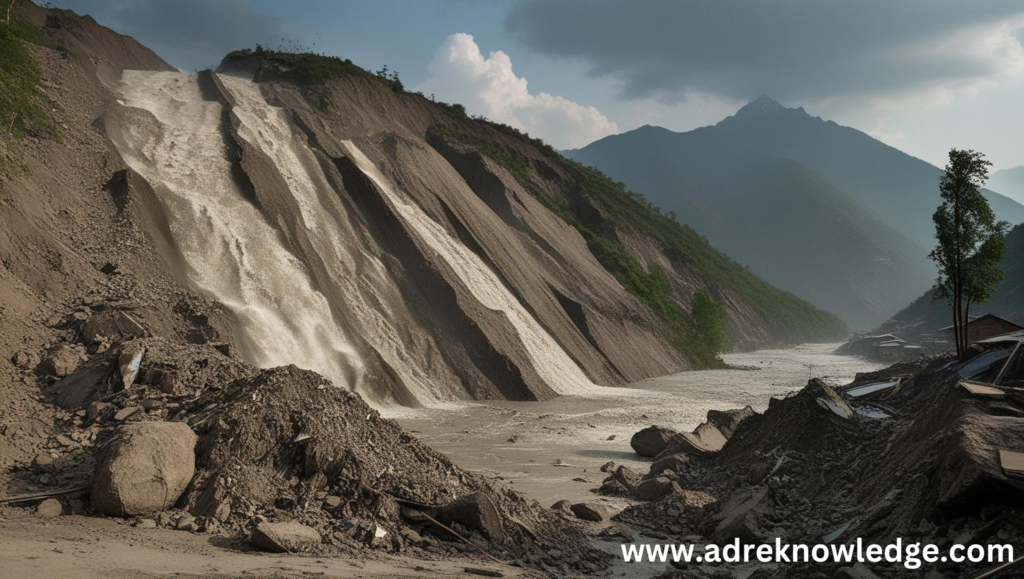
More About Kashmir’s Current Challenges:
Kashmir faces a range of challenges that are deeply rooted in its complex history, political dynamics, and socio-economic conditions. Here are some of the current challenges affecting the region:
1. Political Instability
Conflict and Tensions: The long-standing territorial dispute between India and Pakistan over Jammu and Kashmir has resulted in ongoing military tensions, periodic violence, and a pervasive sense of insecurity. This instability hampers development and affects the daily lives of residents.
Insurgency and Militancy: The rise of militancy in the region, particularly since the late 1980s, has led to violence, loss of life, and disruption of social and economic activities. Ongoing militancy creates a cycle of fear and retaliation.
2. Human Rights Concerns
Violations and Allegations: There have been numerous allegations of human rights violations by security forces, including extrajudicial killings, enforced disappearances, and restrictions on freedom of expression. This contributes to a climate of distrust and fear among the local population.
Civilian Casualties: Frequent clashes between security forces and militants often result in civilian casualties, further complicating the socio-political landscape.
3. Economic Challenges
High Unemployment Rates: Kashmir has one of the highest unemployment rates in India, particularly among youth. Limited job opportunities, especially in the private sector, contribute to frustration and unrest.
Dependency on Agriculture: The economy is heavily reliant on agriculture and horticulture, which are vulnerable to climate change, political instability, and lack of infrastructure. Farmers often struggle with insufficient irrigation, land degradation, and pest infestations.
Impact of Tourism: The tourism sector, a major source of income, has been severely impacted by the political situation. Frequent curfews, shutdowns, and security concerns deter tourists, leading to economic losses for local businesses.
4. Infrastructure and Development Issues
Limited Infrastructure: The region suffers from inadequate infrastructure, including poor road connectivity, insufficient healthcare facilities, and limited access to education. This affects economic growth and the overall quality of life.
Post-Revocation Adjustments: Following the revocation of Jammu and Kashmir’s special status in August 2019, there were significant administrative changes. The shift to Union Territory status raised concerns about local governance, resource allocation, and the implications for regional autonomy.
5. Social Tensions and Sectarian Strife
Ethnic and Religious Tensions: The region is home to diverse communities, including Muslims, Hindus, Sikhs, and Buddhists. Historical grievances and demographic changes have sometimes fueled tensions among these groups.
Youth Radicalization: Economic discontent and political alienation contribute to the radicalization of some youth, leading them to join militant groups or engage in violent protests.
6. Education and Skill Development
Quality of Education: While literacy rates are relatively high, the quality of education and access to vocational training remain concerns. The education system has been disrupted by conflict, limiting opportunities for youth.
Brain Drain: Many educated young people leave the region for better opportunities elsewhere, leading to a loss of talent and skilled workforce in Kashmir.
7. Environmental Challenges
Climate Change: The region faces environmental challenges, including changing weather patterns, glacial melting, and deforestation. These issues impact agriculture, water resources, and biodiversity.
Pollution: Urban areas, particularly Srinagar, face pollution from waste disposal, industrial activities, and vehicular emissions, which threaten public health and the environment.
8. Psychological Impact of Conflict
Mental Health Issues: Prolonged exposure to violence, insecurity, and loss has led to mental health challenges, including anxiety, depression, and post-traumatic stress disorder (PTSD) among the population.
9. Limited Political Representation
Political Disenfranchisement: Many residents feel marginalized and believe that their voices are not adequately represented in the political discourse. The lack of local political power can lead to feelings of alienation and discontent.
10. Future Prospects
Need for Dialogue: A sustainable resolution to the Kashmir conflict requires meaningful dialogue among all stakeholders, including local communities, regional governments, and national authorities. Addressing grievances and fostering a sense of belonging is essential for long-term peace and stability.
Some Importent Question About Kashmir’s Current Challenges:
1. What is one of the major political challenges currently faced by Kashmir?
- A) Territorial dispute with Pakistan
- B) High literacy rates
- C) Low unemployment rates
- D) Abundance of natural resources
- A) Territorial dispute with Pakistan (Correct)
2. What has been a significant impact of the revocation of Jammu and Kashmir’s special status in 2019?
- A) Shift to Union Territory status
- B) Increased autonomy for local governance
- C) Strengthening of local political parties
- D) Increased foreign investment
- A) Shift to Union Territory status (Correct)
3. Which sector in Kashmir is heavily affected by ongoing political instability and violence?
- A) Tourism
- B) Information technology
- C) Renewable energy
- D) Pharmaceutical industry
- A) Tourism (Correct)
4. What is a significant economic issue currently faced by the youth in Kashmir?
- A) High unemployment rates
- B) Overabundance of job opportunities
- C) Excessive government support
- D) High wages in agriculture
- A) High unemployment rates (Correct)
5. Which environmental challenge is Kashmir currently facing due to climate change?
- A) Glacial melting
- B) Increased agricultural productivity
- C) Stabilized rainfall patterns
- D) Lower pollution levels
- A) Glacial melting (Correct)
6. What mental health issue is prevalent among the people of Kashmir due to the prolonged conflict?
- A) Post-traumatic stress disorder (PTSD)
- B) Excessive happiness
- C) No mental health issues
- D) Improved social cohesion
- A) Post-traumatic stress disorder (PTSD) (Correct)
7. Which of the following is a concern related to human rights in Kashmir?
- A) Allegations of extrajudicial killings
- B) High rates of political participation
- C) Freedom of the press
- D) Strong community ties
- A) Allegations of extrajudicial killings (Correct)
8. What type of social tension is prevalent in Kashmir among different communities?
- A) Ethnic and religious tensions
- B) Economic cooperation
- C) Cultural exchange
- D) Educational collaboration
- A) Ethnic and religious tensions (Correct)
9. What has significantly impacted the educational landscape in Kashmir?
- A) Disruption due to conflict
- B) Increased funding for schools
- C) Improved access to higher education
- D) High enrollment rates
- A) Disruption due to conflict (Correct)
10. Which challenge is associated with the loss of talent in Kashmir?
- A) Brain drain
- B) Increased local innovation
- C) High retention of skilled professionals
- D) Abundant job opportunities in the region
- A) Brain drain (Correct)

